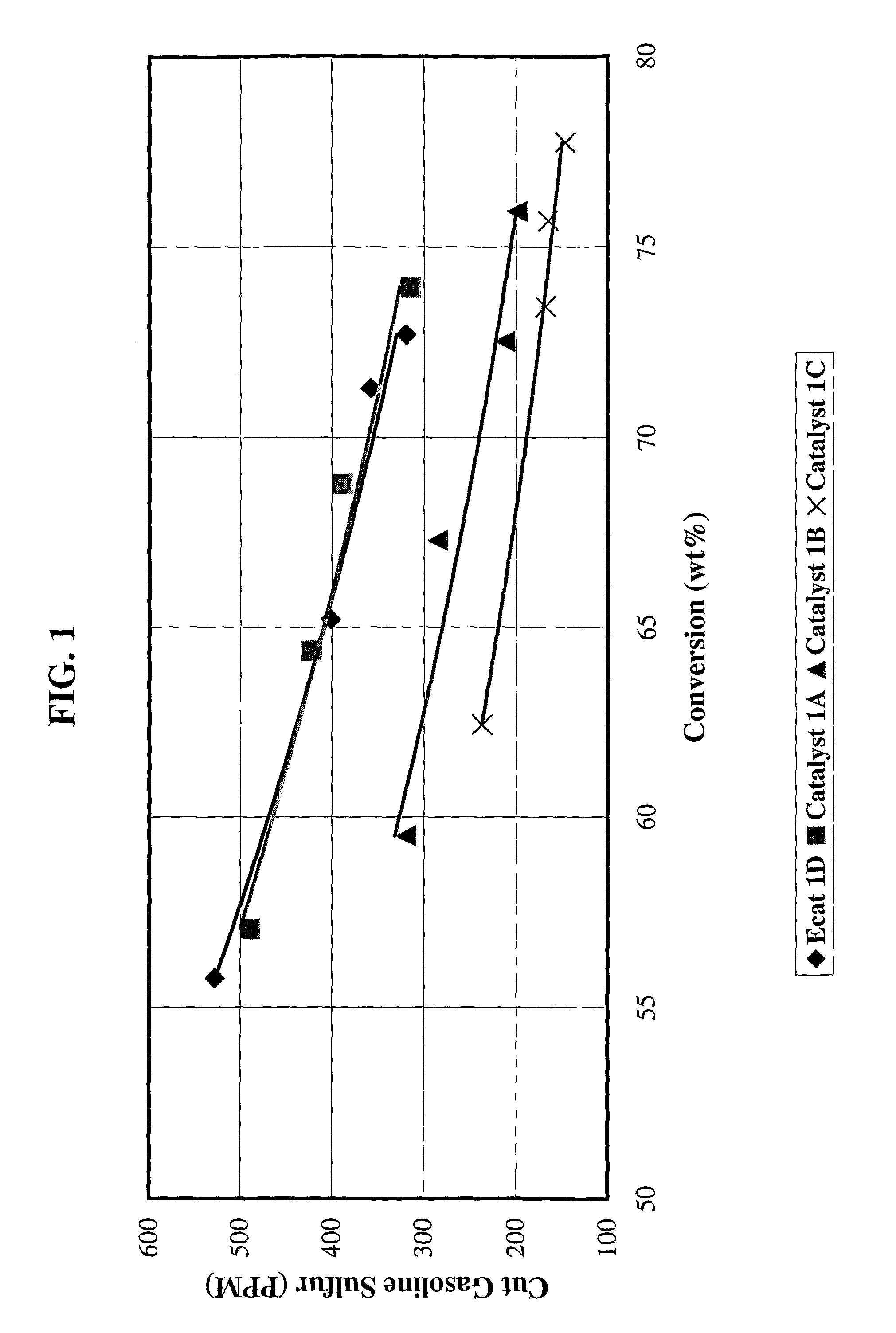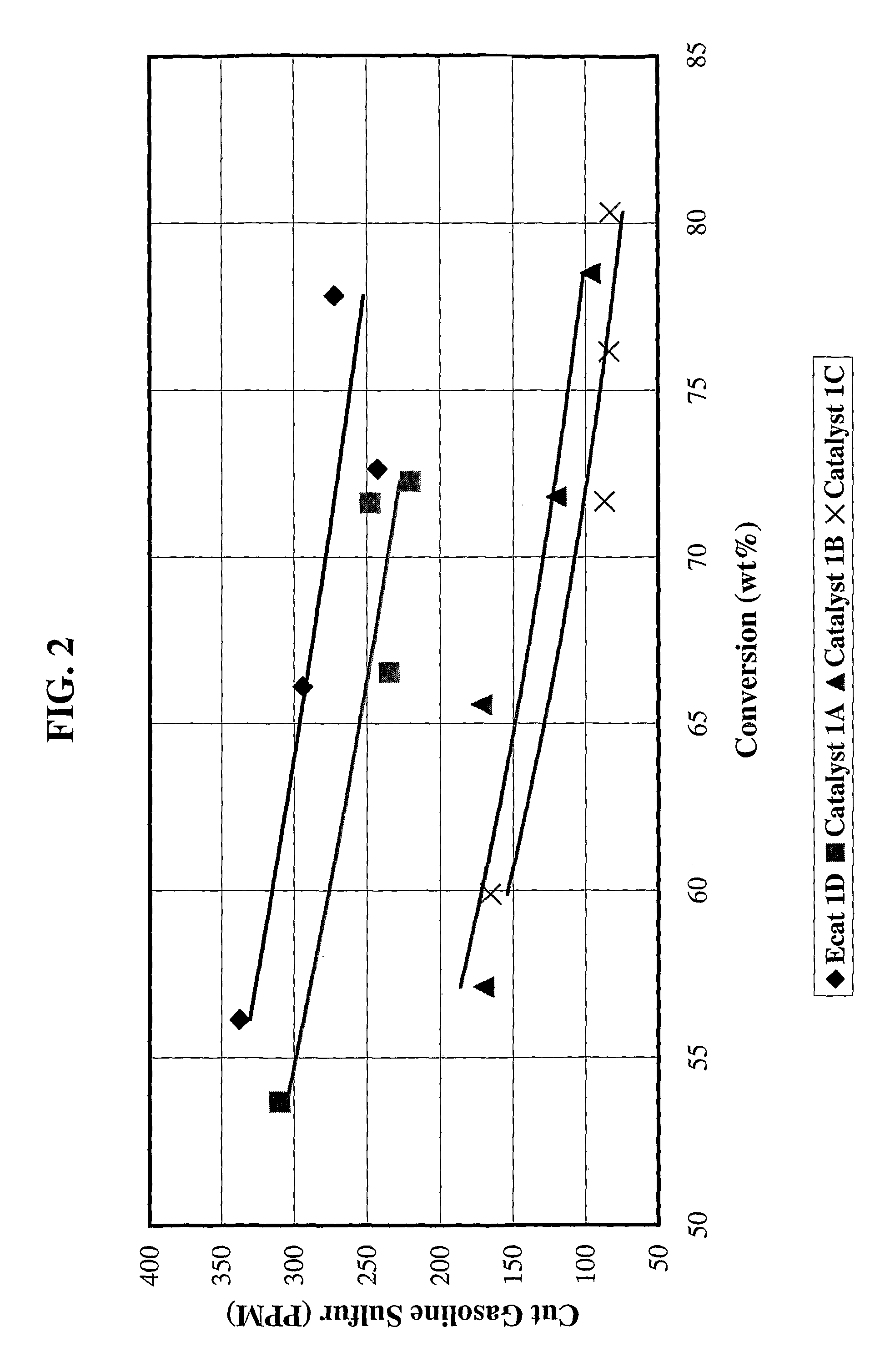Gasoline sulfur reduction catalyst for fluid catalytic cracking process
a sulfur reduction and catalyst technology, applied in the direction of physical/chemical process catalysts, hydrocarbon oil treatment products, chemistry apparatus and processes, etc., can solve the problems of high equipment and operational cost, difficult to remove thiophenic compounds, and high cost of approach, so as to reduce the sulfur content
- Summary
- Abstract
- Description
- Claims
- Application Information
AI Technical Summary
Benefits of technology
Problems solved by technology
Method used
Image
Examples
example 1
[0079]Catalyst 1A: 4203 grams (1350 g on a dry basis) of RE-USY with 8.2% RE2O3, 0.15% Na2O was mixed with 547 g of a ZnCl2 solution containing 29.6% Zinc for 10 minutes. Then, 1761 g (405 g on a dry basis) aluminum chlorohydrol and 2991 g (2542 g on a dry basis) clay were added in the above slurry and mixed for about 10 minutes. The mixture was milled in a Drais mill to reduce particle size and spray dried in a Bowen spray dryer. The spray dried particles were calcined for 1 hour at 1100° F. (593° C.). The physical and chemical properties of the finished fresh catalyst are listed on Table 1.
[0080]Catalyst 1B: 3663 grams (1200 g on a dry basis) of RE-USY with 8.2% RE2O3, 0.15% Na2O was mixed with 486 g of a ZnCl2 solution containing 29.6% Zinc and 667 g of a RECl3 solution containing 19.6% rare earth for 10 minutes. Then, 1565 g (360 g on a dry basis) aluminum chlorohydrol and 2447 g (2080 g on a dry basis) clay were added in the above slurry and mixed for about 10 minutes. The mixt...
example 2
[0103]5000 g Na—Y zeolite was exchanged with ammonium sulfate to lower the Na2O content to ˜4%. Then, 4.62% yttrium was exchanged on the washed Na—Y zeolite by slurrying one part of the zeolite and 10 parts of YCl3 solution that contains 0.051 part of yttrium at pH 5 for 20 minutes followed by filtering and rinsing with 30 parts of deionized water. The exchange zeolite was dried overnight at 120° C. followed by calcination of 2 hours at 1150° F. (621° C.). The calcined zeolite was exchanged again with ammonium sulfate to lower the Na2O content to ˜0.69%.
[0104]A starting base catalyst was made by mixing 3767 grams (1500 g on a dry basis) of the yttrium exchanged zeolite above with 400 g deionized water, 2391 g (550 g on a dry basis) aluminum chlorohydrol and 3471 g (2950 g on a dry basis) clay for about 10 minutes. The mixture was milled in a Drais mill to reduce particle size and spray dried in a Bowen spray dryer. The finished catalysts were calcined and exchanged using ammonium su...
example 3
[0116]The same starting base catalyst in the Example 2 was impregnated with 1.23% yttrium using YCl3 solution to incipient wetness followed by calcinations of 1 hour at 1100° F. (593° C.). The finished catalyst is named Catalyst 3A. Three additional catalysts were made by incipient wetness impregnation of Catalyst 3A using ZnCl2 solution.[0117]Catalyst 3B: 10 g of catalyst 3A were impregnated to a Zn level of 2.39% followed by a calcination of 1 hour at 100° F. (593° C.).[0118]Catalyst 3C: 110 g of catalyst 3A were impregnated to a Zn level of 3.16% followed by a calcination of 1 hour at 1100° F. (593° C.).[0119]Catalyst 3D: 10 g of catalyst 3A were impregnated to a Zn level of 3.97% followed by a calcination of 1 hour at 1100° F. (593° C.).
[0120]All four catalysts were deactivated 16 hours at 1420° F. (771° C.) with 100% steam. The physical and chemical properties of the four catalysts after the deactivation are listed in Table 9.
[0121]All four catalysts were tested in a MAT agains...
PUM
| Property | Measurement | Unit |
|---|---|---|
| particle size | aaaaa | aaaaa |
| size | aaaaa | aaaaa |
| particle sizes | aaaaa | aaaaa |
Abstract
Description
Claims
Application Information
 Login to View More
Login to View More - R&D
- Intellectual Property
- Life Sciences
- Materials
- Tech Scout
- Unparalleled Data Quality
- Higher Quality Content
- 60% Fewer Hallucinations
Browse by: Latest US Patents, China's latest patents, Technical Efficacy Thesaurus, Application Domain, Technology Topic, Popular Technical Reports.
© 2025 PatSnap. All rights reserved.Legal|Privacy policy|Modern Slavery Act Transparency Statement|Sitemap|About US| Contact US: help@patsnap.com



